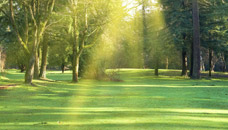Rochester's cemeteries as parks
Oct 25, 2018
But in many ways, cemeteries are ideal places to spend a peaceful morning or afternoon, alone with your thoughts while you're jogging or in the company of friends. There's so much wide open space in the US that we tend to keep parks and burial grounds separate, unlike smaller, older countries where traditionally, the living celebrate being alive in proximity to the remains of the dead. Renée Heininger and Rebecca Rafferty describe their ramble through four of Rochester's park-like cemeteries.
PHOTO BY RENEE HEININGER
Holy Sepulchre Cemetery2461 Lake Avenue Daily, 8 a.m. to 7 p.m. 458-4110 holysepulchre.org A Catholic burial ground, the 332 acres of Holy Sepulchre Cemetery are interspersed with gardens and wide lanes lined by tall, evenly spaced trees. At the entrance are three imposing brutalist crosses, rising from the center of a flower bed, and a gilded replica of Michelangelo's "Pietà" sculpture. Lots of angelic statuary and massive old pines (and more than 100 other types of trees) stand sentinel.
PHOTO BY RENEE HEININGER
...
The Art of Dying Well
Oct 25, 2018
About how we in the United States—and maybe to a slightly lesser degree, here in Colorado and the West—tend to separate ourselves, emotionally and physically, from both the ugliness and the beauty of our inevitable ends. We don’t like to think about dying. We don’t like to deal with dying. And we certainly don’t like to talk about dying. Maybe that’s because acknowledging that human bodies are ephemeral short-circuits American brains groomed to (illogically) hope for a different outcome. Perhaps it’s also because the moment death becomes part of the public discourse, as it has in the Centennial State over the past several years, things can get uncomfortably personal and wildly contentious.More from our October 2018 Issue“As a society, we don’t do a great job of talking about being mortal. My secret hope is that this [new law] prompts talks about all options with dying.”When Coloradans (with an assist from Compassion & Choices, a national nonprofit committed to expanding end-of-life options) got Proposition 106, aka the Colorado End-of-Life Options Act, on the ballot in 2016, there was plenty of pushback—from the Archdiocese of Denver, advocacy groups for the disabled, hospice directors, hospital administrators, and more physicians than one might think. But on November 8, 64.9 percent of voters OK’d the access-to-medical-aid-in-dying measure, making Colorado the fifth jurisdiction to approve the practice. (Oregon, California, Montana, Washington, Hawaii, Vermont, and Washington, D.C., have or are planning to enact similar laws.) Not everyone was happy, but if there’s one thing both opponents and supporters of the legislation can (mostly) agree on, it’s that the surrounding debate at least got people thinking about a very important part of life: death.Photo courtesy of Stocksy“As a society, we don’t do a great job of talking about being mortal,” says Dr. Dan Handel, a palliative medicine physician and the director of the m...



